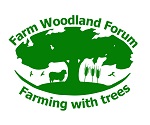In the UK, silvopastoral systems are typically those in which trees are planted at wide spacings into grazed pastures, or existing woodland thinned to allow the undergrowth to flourish. Both systems were common in the past, particularly with the presence of parkland landscapes in large country estates and the ancient practice of pannage in common woodland. The first of these approaches, planting trees into existing pasture, is more common in newer systems.
Both systems offer a wide range of benefits for biodiversity, animal welfare and income diversification. In addition, if there is sufficient complementarity between the requirements of trees and grasses for light, water and nutrients the total production of grass and timber together may be greater than for grass and trees grown in equivalent areas of monoculture (a value known at the land equivalent ratio). Research in the UK in both the uplands and the lowlands has demonstrated that there is little or no reduction in agricultural production, and in some instances there are increases in overall farm productivity.
The use of trees as protection from both sun and wind/rain provides a significant animal welfare benefit and can reduce newborn mortality rates. Additional benefits can also be harnessed by allowing the livestock to browse on the trees or bushes, providing nutrients that would otherwise have to be provided through supplementary feed.
Electric fencing and plastic guards may be suitable protection for rows of new trees. However, a range of fencing and protection types are used depending on the exact systems and costs.
Examples of silvopastoral sites can be found on the FWF agroforestry map (see Agroforestry near you).
For practical information on how to plan, set up and manage a silvopastoral agroforestry system, go to the Silvopastoral Agroforestry Toolbox Website.
